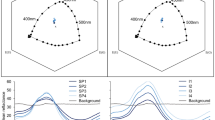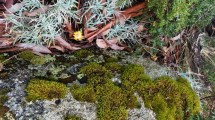Abstract
1. Honeybees Apis mellifera ligustica were trained to work on a patch with artificial rewarding and non-rewarding flowers, coupled to an air extractor. The perceptual colour distance between the rewarding and the non-rewarding flowers was varied and the flower choice and the repellent scent-marking behaviour of the bees were recorded. 2. The discrimination between rewarding and non-rewarding flowers depended on their colour distance, improving with a greater colour difference. This task was guided thus visually and was not affected by activating the air extractor. 3. The scent-marking activity was only observable when the colour information of both groups of flowers was the same or very similar. This thus represents the first reported case of a modulation of an olfactory activity through the visual input provided by colour distances. When the air extractor was activated, rejections associated with the scent-marking behaviour disappeared, thus confirming the olfactory nature of this behaviour. 4. Honeybees are thus capable of using one or more sensory cues to enhance their foraging efficiency, according to the environmental situation. This great plasticity allows them to attain an enhanced efficiency while foraging. 5. We successfully applied the model of colour choice behaviour of the honeybee. Since the original theory was developed for Apis mellifera carnica, this work also constitutes the first attempt to describe the behaviour of the honeybee race, Apis mellifera ligustica, using the postulated model, and reaffirms thus its generality.
Similar content being viewed by others
References
Autrum H, Zwehl V (1964) Die spektrale Empfindlichkeit einzelner Sehzellen des Bienenaugens. Z Vergl Physiol 48:357–384
Backhaus W (1987) Color vision in bees: similarity measures and metric scales of the perceptual space. PhD Thesis, Freie Universität Berlin
Backhaus W (1991) Color opponent coding in the visual system of the honeybee. Vision Res 31:1381–1397
Backhaus W (1992) Color vision in honey bees. Neurosci Biobehav Rev 16:1–12
Backhaus W (1993) Color vision and color choice behavior of the honeybee. Apidologie 24:309–331
Backhaus W, Menzel R (1987) Color distance derived from a receptor model for color vision in the honeybee. Biol Cybern 55:321–331
Backhaus W, Menzel R, Kreißl S (1987) Multidimensional scaling of color similarity in bees. Biol Cybern 56:293–304
Backhaus W, Oberwinkler J, Ehrlich I (1993) Minimal design of multiple color choice experiments with honeybees. In: Heisenberg M, Elsner N (eds) Proc 21 Göttingen Neurobiology Conference 1993. Thieme, Stuttgart, pp 829
Bell WJ (1991) Searching behaviour. The behavioural ecology of finding resources. Chapman and Hall, London
Dusenbery DB (1992) Sensory ecology. How organisms acquire and respond to information. Freeman, New York
Frisch Kv (1919) Über den Geruchsinn der Bienen und seine blütenbiologische Bedeutung. Zool Jb Physiol 37:2–238
Frisch Kv (1967) The dance language and orientation of bees. Belknap Press, Cambridge
Giurfa M (1993) The repellent scent-mark of the honeybee Apis mellifera ligustica and its role as communication cue during foraging. Insectes Sociaux 40:59–67
Giurfa M, Núñez JA (1992) Honeybees mark with scent and reject recently visited flowers. Oecologia 89:113–117
Giurfa M, Núñez JA (1993) Visual modulation of a scent-marking activity in the honeybee Apis mellifera L. Naturwissenschaften 80:376–379
Heß D (1983) Die Blüte. Eine Einführung in Struktur und Funktion, Ökologie und Evolution der Blüten. Eugen Ulmer, Stuttgart
Kien J, Menzel R (1977) Chromatic properties of interneurones in the optic lobes of the bee. II. Narrow band and colour opponent neurons. J Comp Physiol 113:35–53
Masson C, Pham-Delègue MH, Fonta C, Gascuel J, Arnold G, Nicolas G, Kerzberg M (1993) Recent advances in the concept of adaptation to natural odour signals in the honeybee, Apis mellifera L. Apidologie 24:169–194
Menzel R, Ventura DF, Hertel H, de Souza JM, Greggers U (1986) Spectral sensitivity of photoreceptors in insect compound eyes: comparison of species and methods. J Comp Physiol A 158:165–177
Núñez JA (1967) Sammelbienen markieren versiegte Futterquellen durch Duft. Naturwissenschaften 54:322–323
Núñez JA (1971) A simulator for learning studies in the bee Apis mellifera L. Acta Cient Ven 22:101–106
Peitsch D, Fietz A, Hertel H, de Souza J, Ventura DF, Menzel R (1992) The spectral input systems of hymenopteran insects and their receptor-based colour vision. J Comp Physiol A 170:23–40
Ribbands CR (1949) The foraging method of individual honey bees. J Anim Ecol 18:47–66
Schwarz R (1955) Über die Riechschärfe der Honigbiene. Z Vergl Physiol 37:180–210
Vogel S (1983) Ecophysiology of zoophilic pollination. In: Lange O, Nobel P, Osmond C, Ziegler H (eds) Physiological plant ecology III. Tome C of Encyclopedy of Plant Physiology, New Series. Springer, Berlin, pp 559–624
Wehner R (1981) Spatial vision in arthropods. In: Autrum HJ (ed) Handbook of Sensory Physiology, Vol VII 6C, Springer, Berlin Heidelberg New York pp 287–616
Winer BJ (1971) Statistical principles in experimental design. Mc Graw Hill Book, New York
Winston ML (1987) The biology of the honey bee. Harvard University Press, Cambridge Massachusetts
Wyszecki G, Stiles WS (1982) Color science: concepts and methods. Quantitative data and formulae. Second Ed. Wiley, New York
Zielinski R (1978) Erzeugung von Zufallszahlen, Programmierung und Tests auf Digitalrechnern. Deutsch, Frankfurt am Main
Author information
Authors and Affiliations
Rights and permissions
About this article
Cite this article
Giurfa, M., Núñez, J. & Backhaus, W. Odour and colour information in the foraging choice behaviour of the honeybee. J Comp Physiol A 175, 773–779 (1994). https://doi.org/10.1007/BF00191849
Accepted:
Issue Date:
DOI: https://doi.org/10.1007/BF00191849




